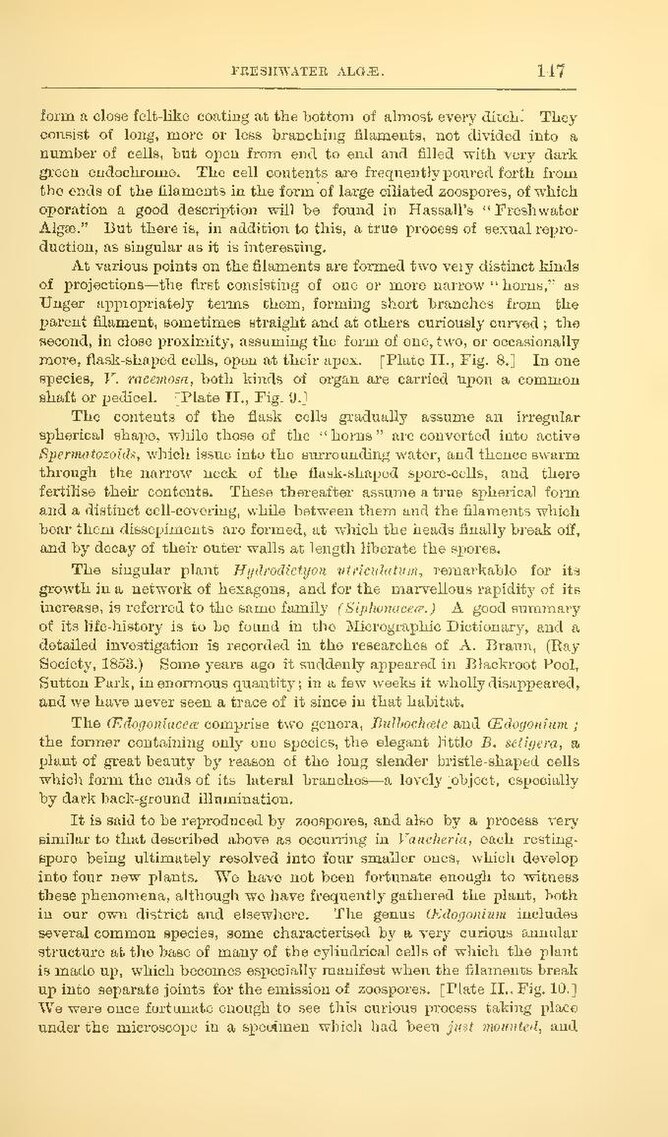form a close felt-like coating at the bottom of almost every ditch. They consist of long, more or less branching filaments, not divided into a number of cells, but open from end to end and filled with very dark green endochrome. The cell contents are frequently poured forth from the ends of the filaments in the form of large ciliated zoospores, of which operation a good description will be found in Hassall's "Freshwater Algæ." But there is, in addition to this, a true process of sexual reproduction, as singular as if is interesting,
At various points on the filaments are formed two very distinct kinds of projections—the first consisting of one or more narrow "horns," as Unger appropriately terms them, forming short branches from the parent filament, sometimes straight and at others curiously curved; the second, in close proximity, assuming the form of one, two, or occasionally more, flask-shaped cells, open at their apex. [Plate II., Fig. 8.] In one species, F. racemosa, both kinds of organ are carried upon a common shaft or pedicel. [Plate II., Fig. 9.]
The contents of the flask cells gradually assume an irregular spherical shape, while these of the "horns" are converted into active Spermatozoids, which issue into the surrounding water, and thence swarm through the narrow neck of the flask-shaped spore-cells, and there fertilise their contents. These thereafter assume a true spherical form and a distinct cell-covering, while between them and the filaments which bear them dissepiments are formed, at which the heads finally break off, and by decay of their outer walls at length liberate the spores.
The singular plant Hydrodictyon utriculatum, remarkable for its growth in a network of hexagons, and for the marvellous rapidity of its increase, is referred to the same family (Siphonaceæ.) A good summary of its life-history is to be found in the Micrographic Dictionary, and a detailed investigation is recorded in the researches of A. Braun, (Ray Society, 1853.) Some years ago it suddenly appeared in Blackroot Pool, Sutton Park, in enormous quantity; in a few weeks it wholly disappeared, and we have never seen a trace of it since in that habitat.
The Œdogoniaceæ comprise two genera, Bulbochæte and Œdogonium; the former containing only one species, the elegant little B. setigera, a plant of great beauty by reason of the long slender bristle-shaped cells which form the ends of its lateral branches—a lovely object, especially by dark back-ground illumination.
It is said to be reproduced by zoospores, and also by a process very similar to that described above as occurring in Vancheria, each resting-spore being ultimately resolved into four smaller ones, which develop into four new plants. We have not been fortunate enough to witness these phenomena, although we have frequently gathered the plant, both in our own district and elsewhere. The genus Œdogonium includes several common species, some characterised by a very curious annular structure at the base of many of the cylindrical cells of which the plant is made up, which becomes especially manifest when the filaments break up into separate joints for the emission of zoospores. [Plate II, Fig, 10.) We ware ounce fortunate enough to see this curious process taking place under the microscope in a specimen which had been just mounted, and
